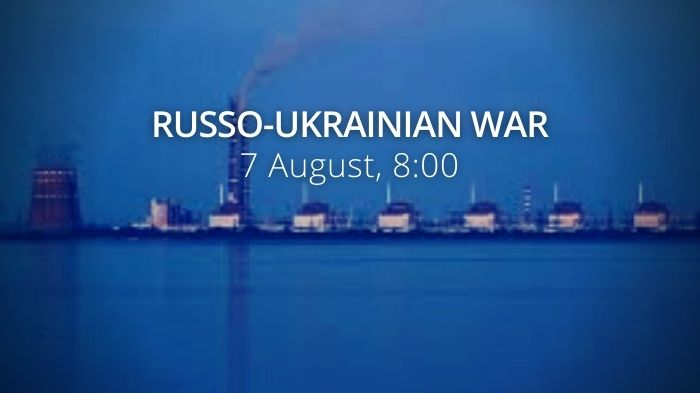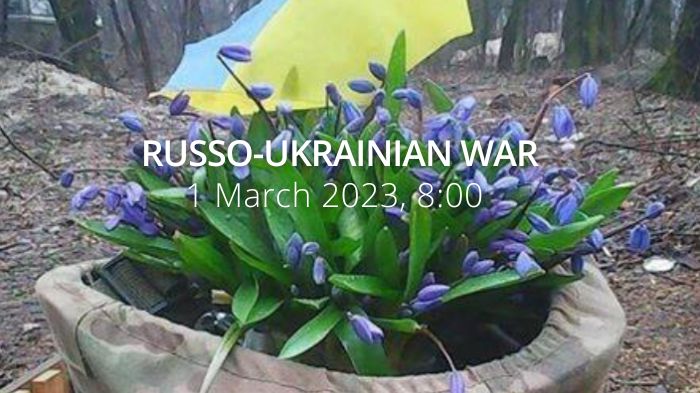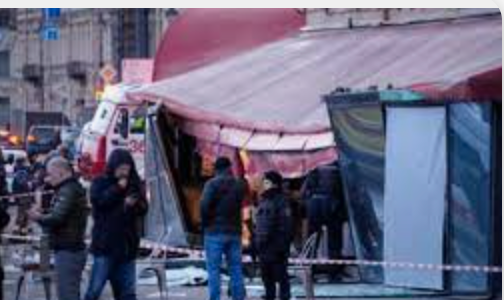Ukrainian partisan activity and civilian resistance ongoing in the occupied territories. Occupiers mine infrastructure in Kherson. The first foreign-flagged ship arrives in Ukraine since February, and awaits grain load. Nuclear disaster possible: IAEA director general requests access to Zaporizhzhia NPP. EU condemns Russia’s activities around Zaporizhzhia NPP. Residents of Zaporizhzhia Oblast are advised to stock up on firewood and insulate their homes. Russian occupiers prepare cages to stage ‘show trial’ of POWs in Mariupol. Russian occupation authorities continue to prepare for the integration of occupied territories into the Russian Federation following their upcoming sham annexation referenda. Ukraine says it will receive tanks and planes from North Macedonia. The US readies a new $1 billion Ukraine weapons package.
Daily overview — Summary report, August 7
A map of the approximate situation on the ground in Ukraine as of 00:00 UTC 07/08/22.
There have been no notable changes to control since the last update. pic.twitter.com/n1U9jW7Z2G
— War Mapper (@War_Mapper) August 7, 2022
According to military expert Stanislav Haider, as of August 7,
Kharkiv Oblast. In the direction of Izium, Ukrainian troops continue their slow advance, and the Russians continue to transfer troops to the south, replacing them here with “LDNR” battalion-tactical groups. Having taken control points south of Brazhkivka, Sulihivka, and Dovhenke, the Ukrainian army has every opportunity for a successful counterattack in the respective directions.
Kherson Oblast. The Ukrainian army repelled all the Russian assaults in all directions. As for the Russians, they are already almost in a state of operational readiness. Ukrainian ground attack aircraft work very systematically – they had about 10 missions yesterday. Russia has to move most of its warehouses south further away from the front beyond the range of the Ukrainian artillery, which increases the distance to deliver shells and fuel.
Zaporizhzhia Oblast. Ukrainian troops are improving their tactical positions in the area of Shcherbaky, Nesterianka, and Dorozhnianka. There is information that the Russians are planning to disconnect the Zaporizhzhia Nuclear Power Plant from the power grid and are mining the facility for destruction.
The work of the Ukrainian artillery:
- Russian bases were destroyed in Donetsk, Snizhne (Donetsk Oblast), Hladkivka district (Kherson Oblast), Polohy district (Zaporizhzhia Oblast);
- Russian ammunition warehouses in Makiivka (Donetsk Oblast), Enerhodar (Zaporizhzhia Oblast);
- An ammo depot and a base were hit in Kherson district;
- Two command points in Chornibaivka (Kherson Oblast).
The General Staff’s operational update regarding the Russian invasion as of 06.00 am, August 7, 2022 is in the dropdown menu below.
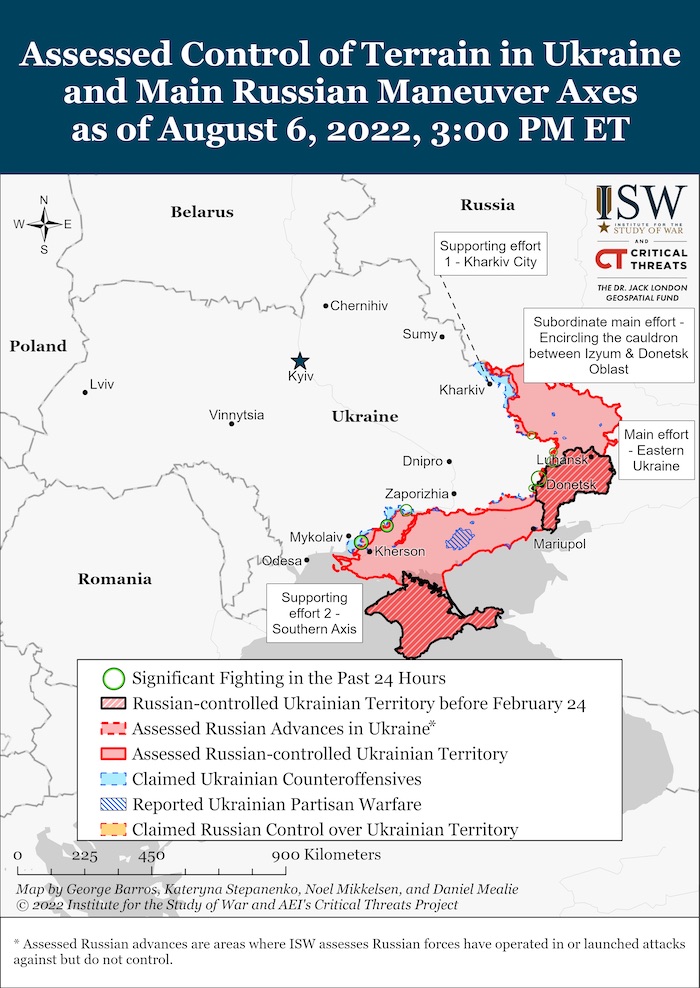
“[The situation has not changed in the Volyn and Polissya directions. The threat of Russian forces launching missiles and airstrikes from the territory and airspace of the Republic of Belarus remains.] According to available information, the armed forces of the Russian Federation are deploying additional forces and means of air defence on the territory of the Republic of Belarus.
In the Siversky direction, Russian forces shelled the areas of the settlements of Hai and Hremyach of the Chernihiv oblast and Novi Vyrky of the Sumy oblast with artillery. [Yesterday, Russian forces carried out artillery fire near Yanzhulivka, Mykolayivka, and Zalizny Mist in the Chernihiv oblast, as well as near Nova Huta in the Sumy oblast.]
[In the Slobozhansky direction:]
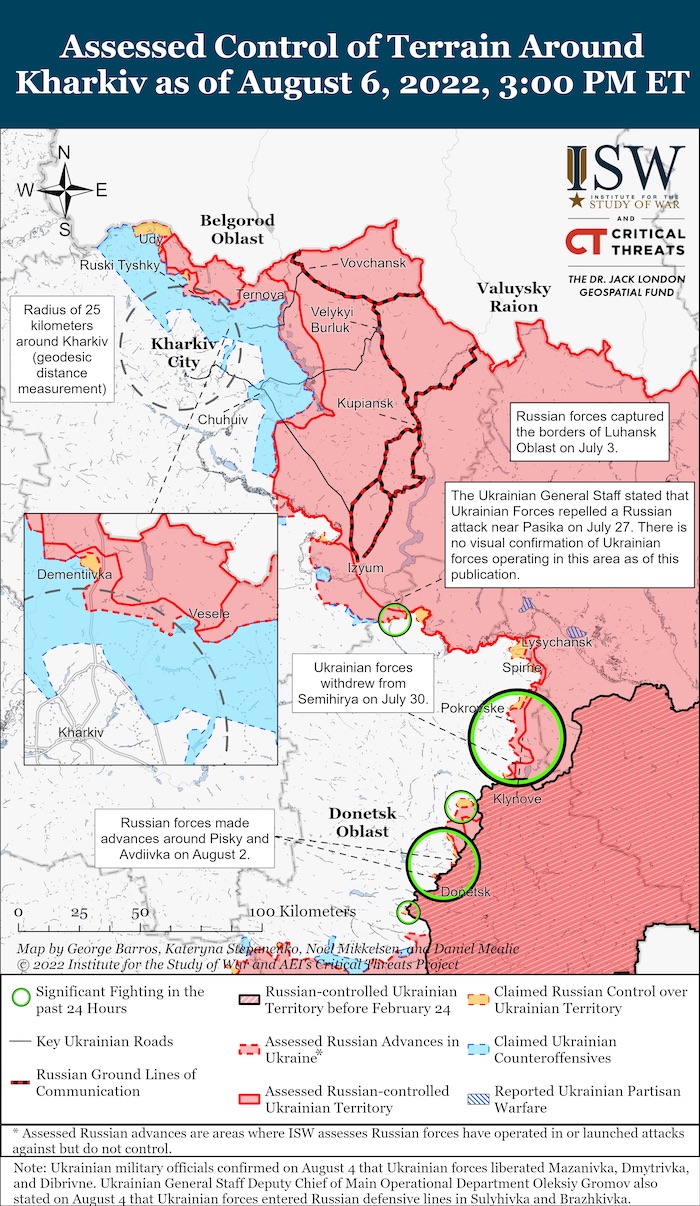
- In the Kharkiv direction, Russian forces fired from artillery and MLRS along the entire line of contact. It carried out airstrikes from helicopters near Verkhnyi Saltiv and Pryshyb. [Yesterday, they used artillery and MLRS for shelling the districts of Prudyanka, Duvanka, Zolochiv and another 27 settlements. Carried out airstrikes near Verkhniy Saltiv, Lebyazhe and Husarivka.]
- In the Sloviansk direction, Russian forces carried out fire damage from artillery of various types in the areas of the settlements of Velyka Komyshuvakha, Brazhkivka, Virnopillya, Sulihivka, Karnaukhivka, Ridne, Dibrivne, Hrushuvaha, Bohorodychne, Nortsivka, and Zalyman. [Yesterday, they carried out fire damage from artillery and MLRS in the areas of the settlements of Velyka Komyshuvakha, Sulihivka, Dovhenke, Dolyna, Mazanivka, Adamivka, Karnaukhivka, Kurulka, Ridne, Dibrivne, Hrushuvaha, Bohorodychne and Mayak.]
- It conducted offensive battles in the area of Bohorodychne and Dolyna, without success. [Yesterday, Russian forces tried to advance to the area of the western outskirts of Bohorodychne, but they did not succeed and retreated.]
- Russian forces used radio-electronic warfare complexes to complicate air reconnaissance.
[In the Donetsk direction:]
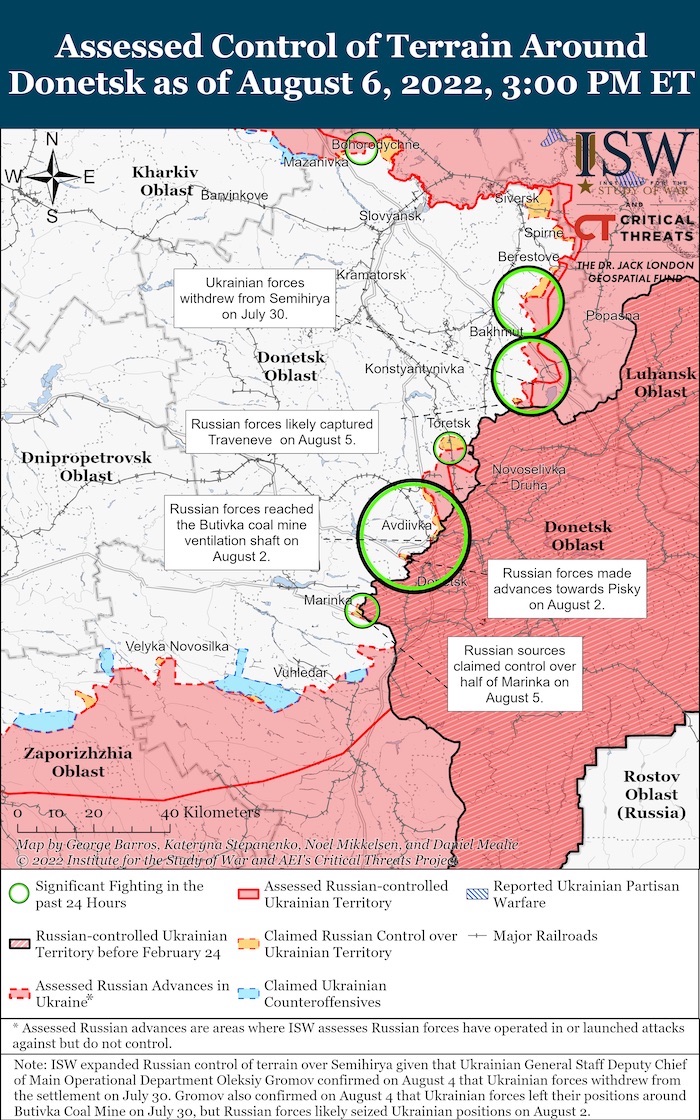
- In the Kramatorsk direction, shelling from tanks, artillery and MLRS was recorded in the areas of the settlements of Kramatorsk, Karpivka, Siversk, Verkhnyokamianske, Pereizne, Hryhorivka, Donetske, Raihorodok, Zvanivka and Ivano-Daryivka. The occupiers launched an airstrike near Spirne with attack aircraft. [Yesterday, they fired from tanks and artillery near Siversk, Serebryanka, Verkhnokamyanske, Dronivka, Donetsk, Hryhorivka, Riznykivka, Mykolaivka, Spirne, Zvanivka, Pereizne, Kalenyky, Dolyna, and Vyimka.]
- Russian forces tried to carry out an offensive in the Verkhnokamyansk region, but were unsuccessful and retreated.
- In the Bakhmut direction, Russian forces fired near Bakhmut, Kostyantynivka, Soledar, Zaytseve, Yakovlivka, Shumy, Kodema, Bilohorivka, Ivanivka, Vesela Dolyna and Bakhmutske. Airstrikes near Zaitseve and Bakhmut. [Yesterday, enemy shelling was recorded near Bakhmut, Soledar, Zaytseve, Yakovlivka, Kodema, Yuriyvka, Bakhmutske, Berestove, Pokrovske and Ivanhrad. Russian attack and army aircraft struck near Zaitseve, Soledar, Bakhmut, Berestove and Yakovlivka.]
- Russian forces conducted assault operations in the directions of Volodymyrivka – Yakovlivka, Pokrovske – Bakhmut, Vidrodzhenya – Vershyna, Novoluhanske – Zaitseve. Ukrainian soldiers held their positions and pushed the invaders back. [The occupiers yesterday tried to improve the tactical position in the directions of Stryapivka – Bakhmutske, Pokrovske – Soledar, Pokrovske – Bakhmut, Volodymyrivka – Yakovlivka, Vidrodzhenna – Vershyna, Pokrovske – Vershyna. In all the indicated directions, Russian forces were resolutely repulsed by Ukrainian soldiers and retreated.]
- Russian forces continue to conduct offensive actions in the directions of Novoluhanske – Kodema, Travneve – Kodema, Semihirya – Zaytseve, and the fighting continues.
- In the Avdiivka direction, the occupiers shelled the areas of Avdiivka, Pavlivka, Pisky, Shevchenko, Netaylove, Nevelske, Oleksandropil and New York with artillery, MLRS and tanks. Airstrikes were carried out near Mykilske, Kamianka, Avdiivka, Volodymyrivka and Mariinka. [Yesterday, Russian forces’ artillery and MLRS shelled the districts of Avdiivka, Pisky, Netailove, Nevelske, and New York. Assault aircraft of the occupiers operated near New York, Krasnohorivka, Pisky, and Mariinka.]
- Russian forces waged offensive battles in the directions of Novobakhmutivka – Krasnohorivka, Spartak – Avdiivka, Vesele – Pisky, but had no success, and retreated. [Yesterday, the Russian invaders tried to break through the defence of our troops in the directions of Spartak – Avdiivka, Vesele – Pisky, Novoselivka Druga – Krasnohorivka, Oleksandrivka – Mariinka, Kyrylivka – Pavlivka and Prechistivka – Novomayorske. Ukrainian soldiers inflicted significant losses on Russian forces and pushed them back.]
- In the Novopavlivsky and Zaporizhzhia directions, shelling from artillery and MLRS was recorded in the areas of Poltavka, Stepove, Trudove, Novomykhailivka, Biloghirya, Novoandriivka, Novopil, Volodymyrivka, Novosilka, Mala Tokmachka, Vremivka, Orihiv, Zaliznychne, Stepnohirsk, Temyrivka, Charivne settlements. Enemy aircraft operated near Vesele, Novodanylivka, Mali Shcherbaky and Novosilka. [Yesterday, Russian forces carried out shelling near Novomykhailivka, Shevchenko, Velika Novosilka, Zaporizhzhia, Zaliznychne, Novodanylivka, Zelene Pole and Charivne. It carried out airstrikes in the areas of Temyrivka, Mali Shcherbaky, Novoandriivka, Vilne Pole, Novosilka, Vuhledar, Pavlivka and Prechystivka.]
[In the Pivdenny Buh direction, Russian forces are trying to hold the occupied positions and prevent the Defense Forces from creating favourable conditions for resuming the offensive and liberating the temporarily captured territory by systematically using the available means of fire damage along the contact line and in the depth of the defence.]
- It carried out airstrikes near Andriyivka, Bilohirka, and Velyke Artakovo. Conducted intensive aerial reconnaissance of the UAVs.
- [Yesterday, the occupiers’ used army aircraft for strikes near Andriivka. Aerial reconnaissance of the area was actively carried out by unmanned aerial vehicles.]
Four warships carrying cruise missiles are operating in the Black Sea.
Ukrainian aviation and missile and artillery units continue to fire at concentrations of manpower, military equipment of Russian occupiers, and warehouses with ammunition. As a result of the losses, Russian personnel in some areas refused to go into battle and resorted to sabotage.
[There remains a threat of missile strikes on military facilities and infrastructure elements throughout the territory of Ukraine.]”
According to British Defence Intelligence, (last 48 hours):
- The poor performance of Russia’s armed forces during its invasion of Ukraine has been costly for Russia’s military leadership, highly likely resulting in the dismissal of at least six Russian commanders since the start of hostilities in February 2022.
- The commanders of Russia’s Eastern and Western Military Districts have highly likely lost their commands. General-Colonel Aleksandr Chayko was dismissed as Commander of the Eastern Military District in May 2022. General-Colonel Aleksandr Zhuravlev, who has commanded the Western Military District since 2018, was absent from Russia’s Navy Day in St Petersburg on 31 July 2022 and has highly likely been replaced by General-Lieutenant Vladimir Kochetkov.
- General Aleksandr Vladimirovich Dvornikov has subsequently been removed after being given overall command of the operation in Ukraine, and General Sergei Surovikin assumed command of the Southern Grouping of Forces from General Gennady Valeryevich Zhidko. These dismissals are compounded by at least 10 Russian Generals killed on the battlefield in Ukraine. The cumulative effect on the consistency of command is likely contributing to Russian tactical and operational difficulties.
- Russian forces are almost certainly massing in the south in anticipation of Ukraine’s counter-offensive or preparation for a possible assault. Long convoys of Russian military trucks, tanks, towed artillery, and other weapons continue to move away from Ukraine’s Donbas region and are headed southwest. Equipment was also reported to be moving from Russian-occupied Melitopol, Berdiansk, Mariupol, and mainland Russia via the Kerch Bridge into Crimea. Battalion tactical groups (BTG), which comprise between 800 and 1,000 troops, have been deployed to Crimea and would almost certainly be used to support Russian troops in the Kherson region. On 02 August 2022, a new BTG had been deployed to Crimea and BTGs are also being re-deployed from Eastern Grouping of Forces. These will highly likely be sent into the Kherson region in the coming days.
- Ukrainian forces are focusing their targeting on bridges, ammunition depots, and rail links with growing frequency in Ukraine’s southern regions. Including the strategically important railroad spur that links Kherson to Russian-occupied Crimea, almost certainly using a combination of block, damage, degrade, deny, destroy, and disrupt effects to try to affect Russia’s ability to logistically resupply.
- Russia’s war on Ukraine is about to enter a new phase, with the heaviest fighting shifting to a roughly 350km front line stretching southwest from near Zaporizhzhia to Kherson, paralleling the Dnieper River..
https://twitter.com/EuromaidanPress/status/1555746251844591616
Losses of the Russian army
As of 7 August, the approximate losses of weapons and military equipment of the Russian Armed Forces from the beginning of the war to the present day:
As of Sunday 7 August, the approximate losses of weapons and military equipment of the Russian Armed Forces from the beginning of the war to the present day:
- Personnel – more than 42200 (+300),
- Tanks – 1805 (+3),
- Armoured combat vehicles – 4055 (+4),
- Artillery systems – 958 (+3),
- Multiple rocket launchers –MLRS – 260 (+0),
- Air defence means – 132 (+5),
- Aircraft – 223 (+0),
- Helicopters – 191 (+0),
- Automotive technology and fuel tanks – 2978 (+8),
- Vessels/boats – 15 (+0),
- UAV operational and tactical level – 750 (+6),
- Special equipment – 86 (+1),
- Mobile SRBM system – 4 (+0),
- Cruise missiles – 182 (+0)
Russian enemy suffered the greatest losses (of the last day) in the Donetsk direction.
3 injured in Russia's rocket attack on Dnipropetrovsk Oblast
11 residential buildings, 40 houses, & a kindergarten were damaged in Nikopol. The city is left without gas, water & electricity, Head of Reg Mil Adm Valentin Reznichenko informed https://t.co/uDwrackki9 pic.twitter.com/KT4S2r3z1y
— Euromaidan Press (@EuromaidanPress) August 6, 2022
Humanitarian
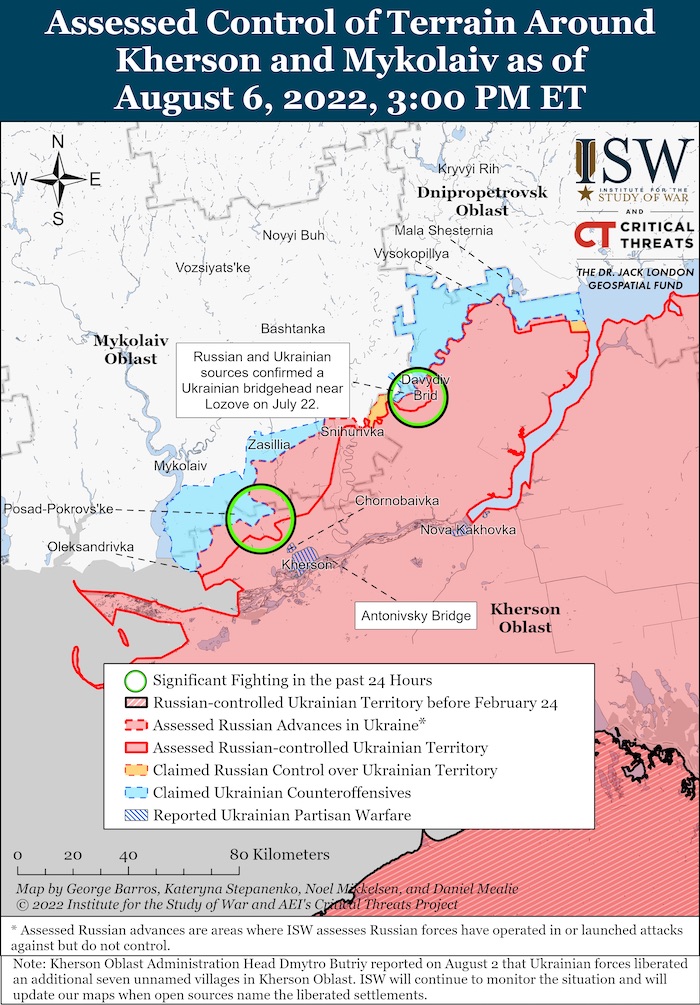
Occupiers mine infrastructure in Kherson – intelligence, Ukrainska Pravda reports. “Today we have information that in Kherson the occupiers have mined vital communications, including the gas, electricity and water supply. This is a terror and scorched-earth strategy that the Russians are preparing for before the inevitable counteroffensive of Ukrainian forces in the south, Andriy Yusov, spokesman for the press service of the Defence Intelligence of Ukraine (DIU) said.
Earlier, Ivan Fedorov, the mayor of Melitopol, reported that the occupiers threatened to blow up the city’s infrastructure in the event of a counteroffensive by the Armed Forces of Ukraine.”
Residents of Zaporizhzhia Oblast are advised to stock up on firewood and insulate their homes, Ukrainska Pravda reports. “Oleksandr Starukh, Head of the Zaporizhzhia Oblast Military Administration, has said that the residents of the oblast should prepare for a tough winter. In particular, he has advised them to stock up on firewood and fuel briquettes. Regarding preparations for the 2022–2023 heating season, Oleksandr Starukh has noted that the Russian invasion will make this winter particularly difficult.
Given the current situation, strategic [fuel] reserves should be created and fuel sources other than gas should be considered. Starukh has also said that the Russian forces had damaged power lines and gas pipelines in the areas where hostilities are taking place.”
https://twitter.com/EuromaidanPress/status/1556067599829458945
The first foreign-flagged ship arrives in Ukraine since February, and awaits grain load, Reuters reports. “A foreign-flagged ship arrived in Ukraine on Saturday for the first time since the war started in February, and will be loaded with grain, Ukrainian Infrastructure Minister Oleksandr Kubrakov said.
The United Nations and Türkiye brokered a deal after UN warnings of possible outbreaks of famine due to a [Russian maritime blockade and a consequential] halt in grain shipments from Ukraine.
Kubrakov said the Barbados-flagged general cargo ship Fulmar S was in the Ukrainian port of Chornomorsk. “We are doing (everything) possible to ensure that our ports can receive and handle more vessels. In particular, we plan to reach the level of at least three to five vessels per day in two weeks (time), he wrote on Facebook.”
The threat of global food shortages after the start of agricultural export from Ukraine? Too soon for unreserved optimism, The Washington Post argues. “When 26,500 tons of corn sailed out of the port of Odesa this week — the first agricultural export from Ukraine since Russia’s invasion — many food security experts breathed a sigh of relief. The news, combined with the falling cost of wheat after global prices had nearly doubled, has investors and policymakers wondering whether the threat of global food shortages is abating.
Not exactly. It’s too soon for unreserved optimism because many of the problems that fueled food inflation even before the Ukraine invasion persist: Energy and agrochemicals prices remain high, making it costly to operate mechanized farms and move food through the supply chain. Scorching weather and drought are decimating farm yields from Waterloo, Canada, to Bangalore and Bordeaux, and climate disruptions are expected to get more varied and extreme.
ME: Additionally, the war shows no signs of abating. Russia is still trying to use energy, food, an unprecedented humanitarian crisis, nuclear safety and not least, war on the European continent to blackmail the West into accepting its demand for control over neighbour territory. International shipping will be transitting the Black Sea under the mercy of a belligerent country which has proven itself utterly untrustworthy. The agreement it signed with the UN and Türkiye has even – and an indication of its “goodwill” – a limited validity (120 days).
️️Environmental
Russian troops are mining Zaporizhzhia NPP – The Insider
According to journalists, explosive cargo is placed near the power units and the engine room. The Russian military has already mined the area around the station https://t.co/umc8jKOSSo
— Euromaidan Press (@EuromaidanPress) August 6, 2022
Russian forces shell Zaporizhzhia NPP for the second time in the past few hours – Energoatom, Ukrinform reports, citing the press service of the National Nuclear Energy Generating Company Energoatom. “On the evening of August 5, Russian terrorists shelled the Zaporizhzhia nuclear power plant for the second time using MLRS. Three shells hit the site of the plant, near one of the power units where the nuclear reactor is located, the report says. There are risks of hydrogen leakage and sputtering of radioactive substances. There is a high fire hazard. There are currently no casualties, Energoatom said.
According to the press service, before the shelling, Rosatom representatives hurriedly left the plant. The Ukrainian staff of the plant is on the ground and performs all measures to ensure nuclear and radiation safety and eliminates the consequences of damage. The invaders earlier fired at the Zaporizhzhia NPP at 14:30. Three explosions were recorded near the plant’s industrial site.
The invaders also bombed the Luch power station, leaving almost the entire town of Enerhodar (six out of seven residential neighbourhoods) without electricity.”
Russia planning to disconnect Zaporizhzhia NPP from Ukraine’s power grid, cut off power in south Ukraine – Energoatom
This makes attacks & nuclear disasters likely; international orgs should push on Russia to withdraw troops from largest NPP in Europehttps://t.co/f1wsf0gRnz
— Euromaidan Press (@EuromaidanPress) August 6, 2022
Russia planning to disconnect Zaporizhzhia Nuclear Power Plant from Ukraine’s power grid, cutting off power in southern Ukraine, Ukrainska Pravda reports, citing Energoatom. “Artillery shelling of the Zaporizhzhia NPP is a terrorist act intended to destroy the plant’s infrastructure, disrupt all of its power lines that feed electricity into Ukraine’s power grid and cut off power in the south of the country. These actions indicate Russia’s turn to a new scenario: one of destruction and [potential] nuclear and radiation disasters at the ZNPP. This is why the attacks on the ZNPP are very likely to continue.
An Energoatom representative has said that coordinated actions on behalf of key security organisations – such as the UN, the International Atomic Energy Agency (IAEA) and the World Association of Nuclear Operators (WANO) – can help prevent these disastrous scenarios from unfolding. In addition, the international community has to put pressure on Russia to ensure the withdrawal of the Russian troops from the largest nuclear power facility in Europe.”
https://twitter.com/EuromaidanPress/status/1555855296140124160
Nuclear disaster possible: IAEA director general requests access to Zaporizhzhia NPP, Ukrinform reports. “IAEA Director General Rafael Mariano Grossi condemned the shelling of the Zaporizhzhia NPP and confirmed his readiness to arrive at the plant leading the agency’s expert mission. […] He added that the IAEA safeguards inspectors would conduct essential verification activities at the plant and would provide impartial and independent information about the status of the Zaporizhzhia NPP.
According to him, the United Nations’ support will also be needed to send a mission. We can’t afford to lose any more time. For the sake of protecting people in Ukraine and elsewhere from a potential nuclear accident, we must all set aside our differences and act, now. The IAEA is ready, Grossi stressed.
He expressed concern about the shelling of the Zaporizhzhia NPP yesterday, which underlines the very real risk of a nuclear disaster that could threaten public health and the environment in Ukraine and beyond. “Military action jeopardizing the safety and security of the Zaporizhzhia nuclear power plant is completely unacceptable and must be avoided at all costs. Any military firepower directed at or from the facility would amount to playing with fire, with potentially catastrophic consequences,” the IAEA Director General noted.”
EU condemns Russia’s activities around Zaporizhzhia NPP, Ukrinform reports, citing the EU High Representative, Josep Borrell. “The EU condemns Russia’s military activities around Zaporizhzhia nuclear power plant. This is a serious and irresponsible breach of nuclear safety rules and another example of Russia’s disregard for international norms. The IAEA must gain access, he wrote”.
Legal
https://twitter.com/EuromaidanPress/status/1555902453354217479
Russian occupiers prepare cages to stage ‘show trial’ of POWs in Mariupol, Ukrinform reports, citing the Mariupol City Council. “Now Russian occupiers are assembling prisoner cages on the stage of Mariupol Chamber Philharmonic. Bars are 20 mm in diameter. The invaders are planning to stage a ‘show trial’ of Ukrainian defenders in September, the report states. Mariupol Mayor Vadym Boichenko called on the international community to not allow this to happen.
The occupiers continue to disregard any international norms. They continue to multiply war crimes, showing disdain for the entire civilized world. I urge the international community, the UN and the ICRC to intervene in the situation and ensure that the rules of the treatment of prisoners of war are respected. We must do everything to bring our defenders back to Ukraine alive and prevent another Olenivka from happening in Mariupol, Boichenko stressed.”
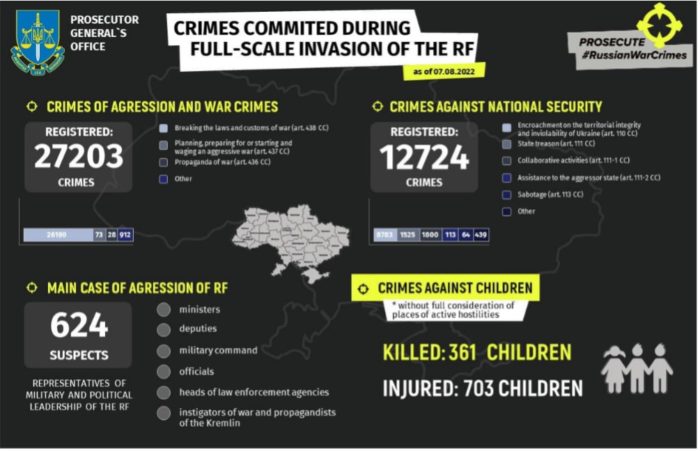
361 children were killed, and 703 children injured, the Office of the Prosecutor General of Ukraine reports as of 7 August. 2,211 educational establishments are damaged as a result of shelling and bombings, 230 of them are destroyed fully. 26,872 crimes of aggression and war crimes and 12,623 crimes against national security were registered.
https://twitter.com/EuromaidanPress/status/1555992570886496258
President Zelensky held a meeting on compensation for damage caused by Russia’s aggression, Ukrinform reports, citing the president’s website. “Zelensky at the meeting noted that the issue of compensation for damages caused by the Russian invasion is an important element of the responsibility that the aggressor state must bear. To develop and implement the compensation mechanism, the President created an ad hoc working group chaired by Head of the Office of the President Andriy Yermak, consisting of representatives of the Cabinet of Ministers and leading Ukrainian and foreign specialists on international law, the report reads.
“Work on the creation of an ad hoc compensation commission through the conclusion of a multilateral international agreement with Ukrainian partners continues. This commission will be able to consider applications for seeking compensation for damage caused by the war,” the report reads.
In addition, an important step to ensure the international legal basis for this mechanism was the adoption of a resolution by the Parliamentary Assembly of the Council of Europe on June 22, 2022, which states that the Council of Europe will promote and ensure the implementation of a comprehensive system of accountability for aggression against Ukraine by implementing an institutional compensatory mechanism for our state. Similar work is being done in the OSCE, the European Parliament, the UN and other organizations.
The President’s Office also noted that Ukraine is also negotiating with partners on how Russian assets, which are currently frozen in various jurisdictions, can be recovered and used for reparations for the damage caused by the war.”
Support
Ukraine says it will receive tanks and planes from North Macedonia, Reuters reports. “North Macedonia has agreed to supply tanks and planes to Ukraine to help fend off Moscow’s ongoing invasion, senior Ukrainian presidential aide Mykhailo Podoliak said on Saturday. Many nations are showing more courage today than half of the G20 (Group of 20 major economic powers). Like North Macedonia, giving Ukraine a (supportive) shoulder in the form of tanks and planes, Podoliak wrote on Twitter.”
The US readies a new $1 billion Ukraine weapons package, Reuters reports. “The Biden administration’s next security assistance package for Ukraine is expected to be $1 billion, one of the largest so far, and include munitions for long-range weapons and armoured medical transport vehicles, three sources briefed on the matter told Reuters on Friday. The package is expected to be announced as early as Monday and would add to about $8.8 billion in aid the United States has given Ukraine since Russia’s invasion on Feb. 24. The officials, speaking on the condition of anonymity, said that President Joe Biden had not yet signed the next weapons package. They cautioned that weapons packages can change in value and content before they are signed.
However, if signed in its current form, it would be valued at $1 billion and include munitions for HIMARS, NASAMS surface-to-air missile system ammunition and as many as 50 M113 armoured medical transports. […]
The new package would be funded under the Presidential Drawdown Authority (PDA), in which the president can authorize the transfer of articles and services from US stocks without congressional approval in response to an emergency. […]
So far the United States has sent 16 HIMARS to Ukraine and on July 1 pledged to send two National Advanced Surface-to-Air Missile Systems (NASAMS). It was unclear if the NASAMS launchers, made jointly by Raytheon Technologies Corp and Norway’s Kongsberg, are already in Ukraine if the munitions were for launchers donated by another country, or if they were being prepositioned.
The United States previously committed 200 M113 armoured personnel carriers to Ukraine. The armoured personnel carriers outfitted with medical equipment could make the fight with Russia more survivable for Ukrainian troops who could then be sent to Germany for further medical treatment.”
ATACMS shelling will likely prove to be an impossible task for the Russian army, Ukrinform reports. “Maintaining an army that does not control the skies and will be under ATACMS (Army Tactical Missile System) fire at any location that Russian forces occupy in Ukraine will likely prove to be an impossible task for the Russian army, [Dan Rice, a US combat veteran and Special Advisor to Valeriy Zaluzhnyi, Commander-in-Chief of Ukraine’s Armed Forces, said].
In his opinion, Russia is having more and more difficulties conducting war in Ukraine, which has done an excellent job of attacking command and control, supply depots and concentrated troop formations. Rice added that the logistics system of the Russian army requires centralized depots, due to the “palletized” manner of logistics, which makes warehouses better targets for HIMARS or M777 precision-guided strikes.
“If, and hopefully when, Ukraine gets the ATACMS munitions, there will be nowhere within Ukraine for Russia to hide neither their command-and-control systems nor supply depots,” Zaluzhnyi’s advisor said. Rice also noted that ATACMS is fired from the standard HIMARS M142 platform, or the M270 MLRS platform and has a range of 300 km.”
Ukraine will not let Russia stop weapons supplies – Kuleba, Ukrinform reports, citing Ukrainian Foreign Minister, Dmytro Kuleba. “Russia knows its aggression is going to fail big time with continued arms supplies to Ukraine. Russia’s task number one is to stop them — be it by missile strikes on logistics or by disinformation on alleged weapons misuse in Ukraine. We will not let any of these efforts succeed, he said.
The Ukrainian Foreign Ministry said on July 21 that Russia was spreading fake news about the alleged misuse of weapons provided to Ukraine by its partners to disrupt their supplies.”
New Developments
https://twitter.com/EuromaidanPress/status/1556052500440047616
- Putin and Erdogan find more room to cooperate at a meeting in Sochi, Russia. The New York Times “President Vladimir V. Putin of Russia and his Turkish counterpart, Recep Tayyip Erdogan, held marathon talks on a range of complementary and clashing interests on Friday, pledging to strengthen economic ties at a time when Türkiye is emerging as the main trade bridge for Moscow to the rest of the world. Russia, constantly probing for ways to evade those sanctions, sees cooperation with Türkiye as a key to easing its economic and political isolation.”
- S. Ambassador to UN: No signs of Russia willing to end the war through talks, Ukrinform reports. “Russia is not seeking to find a diplomatic solution to put the war it is waging against Ukraine to an end. That’s according to Linda Thomas-Greenfield, the United States Ambassador to the United Nations, who spoke in Ghana on Friday during her tour across Africa. I’ve heard many African leaders say they want diplomacy to end the war, and we could not agree more. Moscow and Kyiv will need to find ways to live together in peace. It’s always better to solve disagreements at the negotiating table and not on the battlefield. Unfortunately, we’ve seen no indication that Russia is prepared to accept a diplomatic solution,” said the ambassador. The diplomat also noted that good-faith dialogue and negotiations must be held on terms “the Ukrainians themselves decide.”
Assessment
- On the war.
The Institute for the Study of War has made the following assessment as of 6 August, 2022:
“Russian and Ukrainian forces traded accusations of dangerous shelling at the Russian-occupied Zaporizhzhia Nuclear Power Plant (NPP) on August 6 continuing the exchange of accusations ISW reported on August 5. ISW cannot independently determine which party is responsible for the incident. Ukrainian President Volodymyr Zelensky condemned the alleged Russian shelling as an “open, brazen crime” and “an act of terror.” He called on the international community to designate Russia as a state sponsor of terrorism and to sanction Russia’s nuclear industry. Both sides claimed that the shelling caused a fire at the hydrogen station at the plant. The Russian-appointed head of the Zaporizhzhia Oblast Occupation Administration, Evgeniy Balitskyi, claimed on August 5 that Ukrainian forces “decided to put the whole of Europe on the brink of a nuclear catastrophe” by shelling the plant. The Ukrainian head of the Zaporizhzhia Oblast Military Administration, Oleksandr Starukh, claimed on August 6 that Russian forces are trying to “provoke” Ukrainians into shelling the NPP to make the West hesitant to provide weapons to Ukraine.
A Russian opposition outlet reported that Russian forces are storing explosives and ammunition around the nuclear power plant. The Insider reported on August 5 that a source claimed Russian forces mined the turbine room of energy block 1 of the NPP around August 2. A separate source claimed that about 500 Russian soldiers, as well as armored personnel carriers and anti-aircraft guns, were stationed within the plant and that Russian forces mined the area around the plant. The second source said that Russian forces “store mines and ammunition in the immediate vicinity of the energy blocks, under trestles, with some of the ammunition stored inside the energy block.” The second source was unsure “whether the energy block has been mined or is simply used for storing explosives.” The Insider reported that Russian forces established Grad rocket batteries near the village of Vodyane, approximately 4 km from the NPP reactors (and approximately 2 km from the spent fuel containment units at the plant). Ukrainian channels and officials had reported in mid-July that Russian forces were firing on Nikopol—the Ukrainian town just across the river from the NPP—from near the nuclear reactors at Zaporizhzhia NPP. Ukraine’s Southern Military Command has subsequently reported that Russian forces have regularly shelled Nikopol with Grad rockets, damaging 47 houses on August 5 and 6.
ISW previously assessed on August 3 that Russian forces are likely using the NPP to play on Western fears of a nuclear disaster in Ukraine in an effort to degrade Western will to provide military support to a Ukrainian counteroffensive, while also effectively using the plant as a nuclear shield to prevent Ukrainian strikes on Russian forces and equipment.
Key Takeaways
- A Russian opposition outlet reported that Russian forces are storing explosives and mines in and around Zaporizhzhia Nuclear Power Plant and may have mined parts of the plant. Russian forces may also be firing rockets at Ukrainian positions from within or near the plant.
- Russian forces conducted limited ground attacks northwest of Sloviansk and east and south of Bakhmut.
- Russian forces conducted a series of ground attacks to attempt to break through Ukrainian defensive lines north, west, and south of Donetsk City.
- Russian forces did not conduct offensive operations in southern Ukraine and continued to undertake defensive measures.
- Ongoing Ukrainian partisan activity and civilian resistance are frustrating Russian occupation forces as Russian occupation authorities continue to prepare for the integration of occupied territories into the Russian Federation following their upcoming sham annexation referenda.
Two top Russian collaborators suffered apparent assassination attempts in Ukraine’s occupied Kherson Oblast, where a partisan resistance is underway.https://t.co/XLjvvooWlk
— Euromaidan Press (@EuromaidanPress) August 6, 2022
Russian state media advocated for labor camps, repressions, and shooting of Ukrainian partisans and civilians that refused to cooperate with Russian-appointed officials in occupied Ukrainian territories.”
2. Consequences and what to do?
‘Realists’ have it wrong: Putin, not Zelensky, is the one who can end the war, Michael McFaul wrote in an Op-ed in The Washington Post. “Ukrainian President Volodymyr Zelensky gets a lot of advice on how he can end the war in his country, and most of it pushes in one direction: Swap some sovereignty for peace. If only Zelensky would give Russian President Vladimir Putin another chunk of Ukrainian territory, the argument goes, the war would end.
In May, Zelensky reported that French President Emmanuel Macron “suggested to me certain things related to concessions on our sovereignty in order to help Putin save his face.” Henry A. Kissinger echoed that advice. Speaking at the World Economic Forum that same month, the former US secretary of state warned Western leaders not to push Putin into an embarrassing defeat, and instead suggested they urge Zelensky to give up Ukrainian territory as a means to ending the war. Op-ed pages in Europe and the United States have been filled with self-appointed strategists suggesting ways for Zelensky to halt the carnage.
And Ukrainians I know harbor a very specific, private worry: Should Putin succeed in fully taking Donbas, he might declare his war of conquest over for now, quickly prompting some Western leaders to urge Zelensky to accept the loss of occupied land as the price of peace.
Strangely, few in this army of advisers direct their wisdom toward Moscow. Why does no one offer Putin advice on how to end his invasion? To those claiming to make the “case for diplomacy,” in alleged opposition to the “case for war,” please detail how you would persuade or compel Putin to stop the conflict. Real diplomacy takes two to tango. Recommendations for peace that instruct only Zelensky to capitulate are not only repulsive, but also highly unrealistic.
The repulsive part should be obvious. Putin was not provoked into invading; Russia faced no security threat from Ukraine. Putin has now recognized two regions of Ukraine — Donetsk and Luhansk — as independent states, and he has plans to annex them, along with other southern Ukrainian cities and regions that together constitute what Putin calls “Novorossiya.” To try to please Putin by giving him more territory would normalize annexation and reward imperialism.
And no, this is not just what great powers do. After World War II, the great powers endorsed a set of norms to prevent annexation and end colonization. For several decades thereafter, including during the Cold War, they were rare. Giving Putin more Ukrainian land now would not only radically undermine Ukrainian sovereignty, but it would also threaten to unravel the post-World War II international system more generally. If Russia is allowed to forcibly annex neighboring territory, what would stop other countries from doing the same?
The self-appointed Zelensky advisers understand these distasteful facts. They just claim to be realists and assert that their proposal — land for peace — is the only way to end the war. But they are in fact unrealistic, if not downright naive, about Putin and power.
Putin already annexed part of Ukraine in 2014. Conquest of Crimea did not satiate him then. Why wouldn’t Putin pocket new gains from 2022 and then prepare for yet another war?
You don’t have to take my word for it; listen to what Putin himself has said. Putin claims that Ukrainians are just Russians with accents and have no historical claim to statehood. Putin also promised to “denazify” Ukraine, a bizarre euphemism for overthrowing the democratically elected Zelensky.
Just days ago, Russian Foreign Minister Sergei Lavrov reaffirmed this Russia war objective, declaring, “We will certainly help the Ukrainian people to get rid of the regime, which is absolutely anti-people and anti-historical.” Already, Putin has tried to seize the country’s capital, Kyiv, and he has not once mentioned abandoning that military objective.
Acquiring Donbas, or “Novorossiya,” might delay Putin’s pursuit of these other military objectives, but it will not stop them. If Zelensky gave Putin more Ukrainian territory today, Putin would demand more tomorrow — more land, more influence over the Ukrainian government, certainly more control throughout in Ukraine.
Moreover, Putin thinks he is winning. Using barbaric methods of terrorizing civilians with long-range artillery shells and rockets, Putin’s army is making incremental progress on the battlefield. So why would he quit now?
History teaches that wars tend to end in two ways. Either one side wins, or a grinding stalemate is reached. Neither of those conditions exists yet in Ukraine. No matter what Zelensky says or gives, Putin will not stop fighting until his army can no longer move forward.
The real party of peace is not those advising Zelensky to give Putin more land. It is those pushing the West to supply the Ukrainian army with more and better weapons, and as fast as possible. Without a stalemate on the battlefield, Putin will never negotiate. The faster Ukraine’s army can stop Russia’s, the sooner Putin’s war will end.
Hans Petter Midttun: I hope I am wrong. I would love to read a serious plan for persuading Putin to end his invasion. But Western recommendations aimed only at pressuring Zelensky to quit won’t work. Putin, not Zelensky, is the key decision-maker for ending the Russian invasion of Ukraine. If your plan for peace does not spell out a way to change Putin’s calculus, there’s nothing realistic about it.”
Hans Petter Midttun:
Countries aspiring to join NATO have to demonstrate that they are in a position to further the principles of the 1949 Washington Treaty and contribute to security in the Euro-Atlantic area. They are also expected to meet certain political, economic and military criteria, which are laid out in the 1995 Study on NATO Enlargement. The criteria include a functioning democratic political system based on a market economy; fair treatment of minority populations; a commitment to resolve conflicts peacefully; an ability and willingness to make a military contribution to NATO operations; and a commitment to democratic civil-military relations and institutions.
NATO’s “open door policy” is based on Article 10 of its founding treaty. Any decision to invite a country to join the Alliance is taken by the North Atlantic Council based on consensus among all Allies. The Alliance stresses that no third country has a say in such deliberations.
That is, however, not “the whole truth, and nothing but the truth.”
In the article “NATO’s membership rules invite conflict — and benefit Putin” published by The Washington Post on 22 February, Brett V. Benson and Bradley C. Smith argue that:
“the relationship between alliance formation — imminent partnerships, especially — and war is a close one, as we explored in a recent scholarly article. In 1939, for instance, Britain made a commitment to defend Poland but was not able to make good on the pledge right away. Germany attacked Poland before Britain and France could get into position. In 1954, the Chinese communists attacked islands held by the Chinese nationalists in a failed attempt to block an alliance between the United States and Taiwan. And in a situation with marked parallels, albeit on a smaller scale, to the current crisis in Ukraine, Russia attacked Georgia in 2008 after NATO membership for that country was proposed. Perhaps not coincidentally, Georgia is still not a NATO member.”
In 2014, Russia attacked Ukraine and the country remains a non-member to this day.
The relationship between a potential NATO membership and Russian aggression is linked to several factors. Firstly, for a country to join NATO, unanimous approval is required. All existing 30 member states need to approve. While all share the advantage of collective defence, they do not share national interests. Many have until recently, had strong diplomatic, economic and energy ties to Russia. The latter only needed to convince one out of the thirty that Ukrainian NATO membership conflicted with its interests, to stop the process.
Secondly, the NATO membership process is long and requires a multi-stage process to be completed before membership is accepted. Despite having decided to speed up the accession process for Sweden and Finland, the process is still expected to take up to one year. As demonstrated in both Georgia and Ukraine, it gives ample time for Russia to intervene militarily. Though Russia is the instigator of the conflict in both countries, some of the NATO members are not willing to look past this crucial detail. Instead, there are concerns that granting the two NATO membership could make NATO a party to the ongoing wars.
As repeatedly stressed, however, NATO is also a party to the conflict. Ukraine is only an objective of a broader conflict between Russia and the West. It is a fight between the autocratic “Russian world” and Western liberal democracy. Russia has already defined NATO as a threat and a party to the conflict. It has publically declared that the West is waging an information war, economic war, acts of aggression, war with Russia through a proxy and a total war. It sees our defence aid to Ukraine as proof of our participation. In December 2021 it even handed over a set of ultimatums to the USA and the Alliance after having waged a Hybrid War against the West for years.
The fact that the war itself threatens European security, stability and prosperity, makes us all a party to the war.
A Ukrainian NATO membership will, therefore, not make the Alliance a party to the conflict. We already are! NATO tries, however, to define itself as a semi-active participant, desperately trying to avoid living up to its commitment to ensuring security in the Euro-Atlantic area.
The conflicting national interests, the extremely long membership process and the fear of being drawn into ongoing conflicts (which started to trigger that particular fear) have in effect given Russia a say in NATO’s membership deliberations.
It is, therefore, ironic that a military alliance established to contribute to security in the Euro-Atlantic area is excluding the only Western country that is actively fighting for European security and stability.
Ukraine is not only fighting for its independence and sovereignty and its right to exist as a nation but is also defending our shared values and principles. It is standing up for the international security architecture while stopping Russia from expanding westward by force.
It is even more paradoxical when considering that Ukraine is among the very few countries that meet the NATO target of 2% of GDP defence spending and 20% equipment expenditure as a share of defence expenditure. Alongside Ukraine, only Croatia, Estonia, Greece, Latvia, Lithuania, Poland, Romania, the UK and the USA meets the NATO targets. None of the other NATO members is meeting the requirement for membership.
Having effectively denied Ukraine NATO membership, Russia’s action mustn’t continue to deny Ukraine the tools it needs to defeat and evict Russia.
More importantly, its False Flag Operations against politically sensitive targets (e.g. attacks on nuclear power plants, Ukrainian POWs, and civilian targets in occupied territories) must not impair continued Western supplies of long-range ammunition and weapons.




